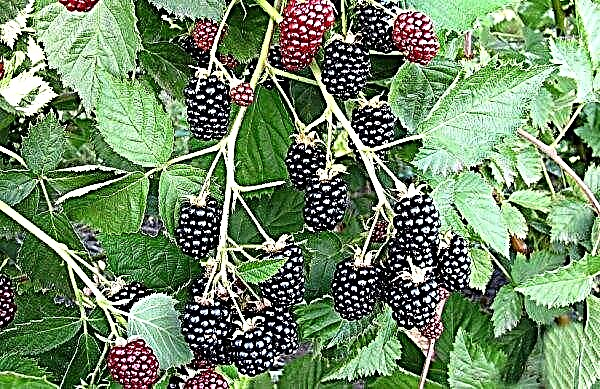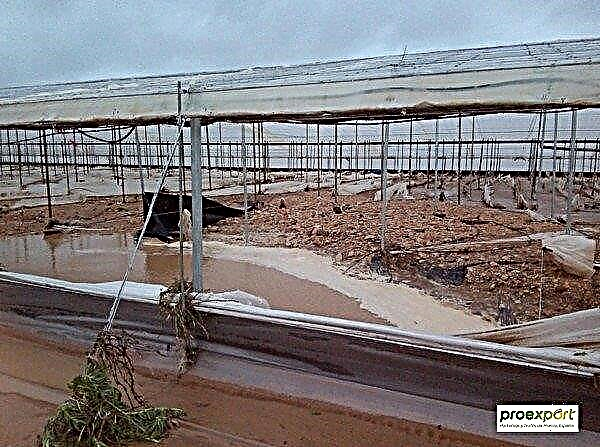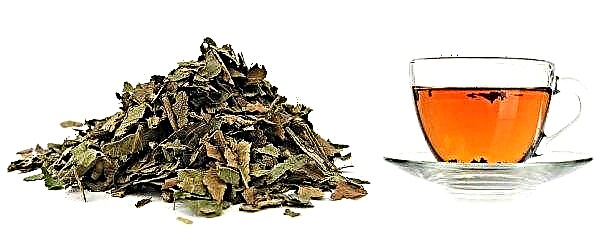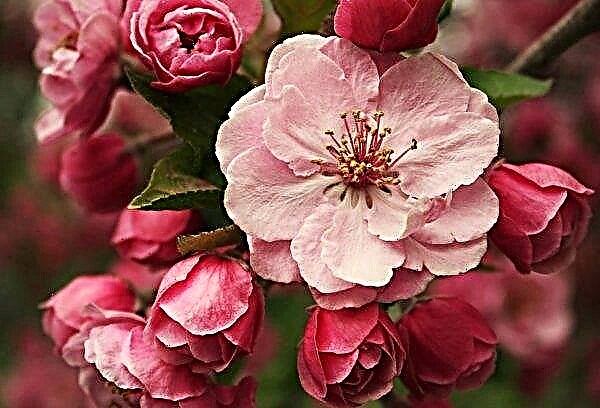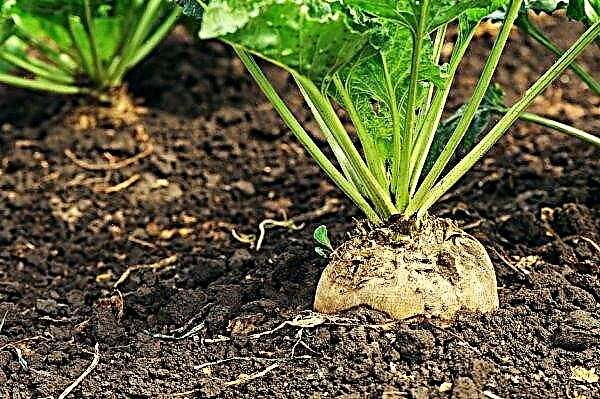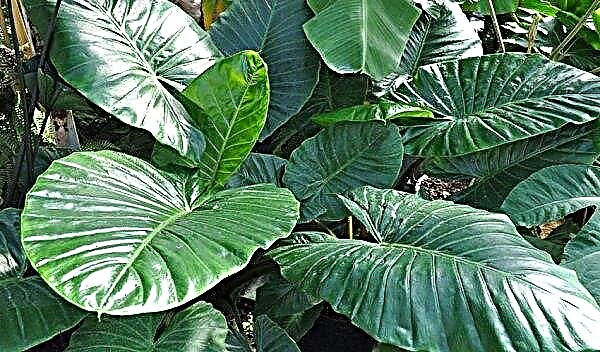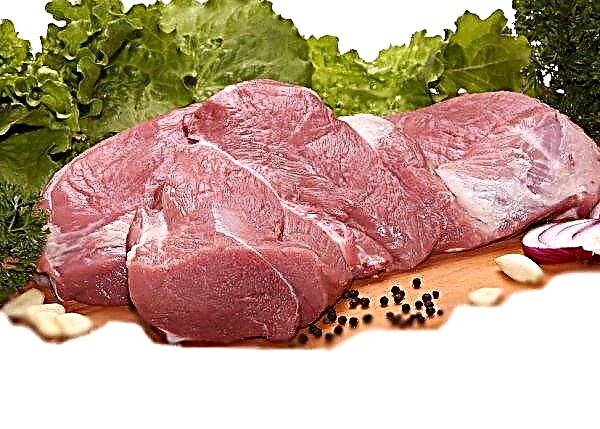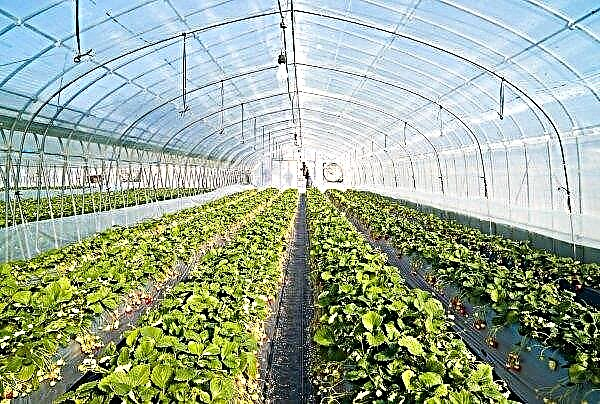Molds appear when food is in a place with a lot of moisture.. Champignons are no exception: they can also grow moldy - become covered with a white fluff. In the article you will find answers to questions about whether mushrooms become toxic after that and what needs to be done to avoid diseases that arise during the cultivation and storage of mushrooms.
Champignon diseases
Mold is a general term for several types of fungi. It cannot appear suddenly, because its spores are always in the air, and if there are suitable conditions, they settle on the surface and germinate in a new place, covering it with fresh bacterial plaque.
 Under a microscope, it looks like thin mushrooms, the body of which consists of a root penetrating the product and a stem rising above it. Unlike unicellular bacteria, mold consists of many cells and can be seen with the naked eye.
Under a microscope, it looks like thin mushrooms, the body of which consists of a root penetrating the product and a stem rising above it. Unlike unicellular bacteria, mold consists of many cells and can be seen with the naked eye.
The fluff that we see is mold spores. They "swell", covering the surface on which are mycelium. You can find molds of many shades: white, green, yellow. Some of the varieties are very difficult to clean.
Spores are toxic and may cause an allergic reaction.. But not every type of mold is dangerous. Some are used to make bread, wine, high-quality cheeses, and even medicines. Known to everyone, penicillin is a hardened mold.
Important! Molds can cause more frequent respiratory infections in people who work or live in a polluted room. Key signs of infection include nasal congestion, eye irritation, coughing, shortness of breath, and asthma-like symptoms.
Growing champignons, farmers will inevitably be faced with the fact that the land cover, compost and even the premises can become moldy. The treatment process shows that mold removal is difficult. This is facilitated by the conditions in which the mushroom farm functions. Some of these diseases can ruin the crop in just a week, so it is important not only to know about their existence, but also to be able to cure them in time.


The main diseases of champignons:
- verticil (verticillosis);
- mycogon;
- arachnoid mold (dactylium);
- green mold;
- false truffle;
- yellow mold;
- olive mold;
- ink mushroom;
- bacteriosis (bacterial spotting).
Did you know? Mold destroys more wood than fires, floods, and termites combined.
Verticillosis- The most common and serious fungal disease in crop production. If no action is taken, then the disease can destroy the crop in 2 weeks.
- Pathogen: Verticillium fungicola. It affects young mushrooms at the pinhead stage. Distributed with air, carried by people, animals and plantation care items.
- Symptoms: yellowish mycelium forms on the integumentary soil. If adult fungi are affected, then the deformation of the leg occurs. Affected specimens become grayish in color, later the spots darken to brown. The hats begin to wrinkle and become cracked.
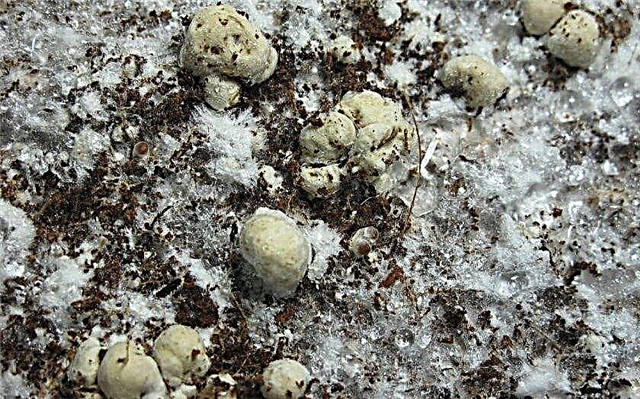
- Prevents the fight against the disease high humidity, lack of good air circulation, delayed harvesting and temperatures above 16 ° C.
- Methods of struggle: use of sterilized instruments, maintaining room hygiene, disposal of spent compost, steaming the soil with steam at a temperature of 55 ° C for 15 minutes. Processing is carried out for 2-3 weeks. It must be borne in mind that the fungus can remain in the soil for up to 1 year. Of chemical methods, spraying is used with "Topsin", "Mirage", "Sporgon".
Mikogon- A disease that occurs on the surface of champignons, causing deformation of the fruiting body. Synonymous names are wet rot, white rot.
- Pathogen: Mycogone perniciosa.
- Symptoms: The surface is covered with brown spots that begin to rot, releasing drops of yellow liquid. Rotting is accompanied by an unpleasant odor. Fluffy spots appear on the soil - this is the mycelium of the fungus. Usually the source of infection is the soil. The infection can also be transmitted by air, with water, or mechanically transmitted by ticks.
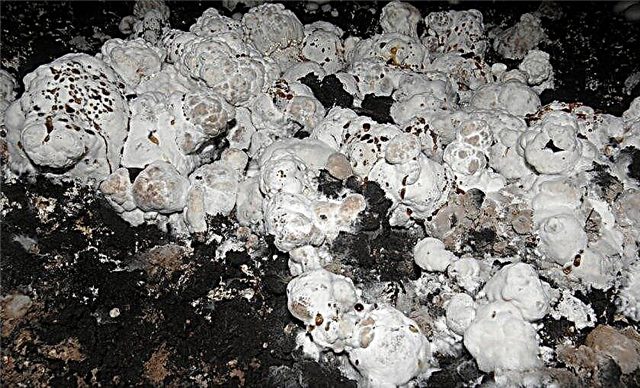
- Methods of struggle: pathogen growth becomes weaker or stops at pH 8.4. To solve the problem, soil treatment using steam at 55 ° C for 15 minutes is used. They also spray with Benomil.
Yellow mold - fungal disease.
- Pathogen: Myceliophthora lutea, Chrysosporium luteum, C. sulphureum
- Symptoms: appears as yellow or red spots on the compost. At first, like green, it appears as a fluffy white cover on the site. Then it takes on a greener shade. Where there is a lot of mold, you can feel a steady metallic smell. The pathogen is the cause of the violation of the soil connections of the mycelium and its subsequent death.

- Methods of struggle: Considering that this is the most difficult type of mold to be removed, the material used must be carefully processed. The pathogen spores are resistant to high temperatures.
Olive mold at the initial stage of development, it is similar to champignon mycelium. With age, it darkens and acquires an olive, and then a black tint.
- Pathogen: Chaetomium olivaceum, C. globosum.
- Symptomatology: may occur 10 days after planting champignons. At the initial stage, it resembles grayish streaks on compost. If you find this disease, it means that the compost was initially poor quality.
- Control measures: For prophylaxis, follow composting technology and indoor hygiene.
Did you know? Mold - This is one of the few organisms that does not need light for growth and development. Accordingly, it can thrive in dark and humid places.
Ink mushroom (dung beetle) is another disease of poor-quality compost.
- Symptomatology: Appears on the beds before the appearance of mushrooms. It looks like a mushroom with a bell hat.
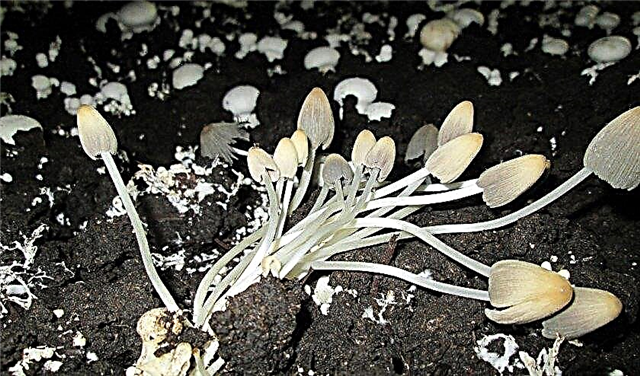 At the beginning of development, it is creamy white, then gradually darkens and turns into a slimy shapeless black mass. The mushroom is a sign of the high nitrogen content in the compost heap and an indication that the compost was old.
At the beginning of development, it is creamy white, then gradually darkens and turns into a slimy shapeless black mass. The mushroom is a sign of the high nitrogen content in the compost heap and an indication that the compost was old. - Control measures: To prevent infection, it is necessary to strictly observe the compost manufacturing technology.
Bacterial spottingbegins with the spread of pathogenic bacteria in the soil.
- Pathogen disease: Pseudomonas tolaasii.
- Symptoms: Bacteria do not develop mycelium, but they can multiply on the surface of the fungi, covering the hats with yellow-brown spots. Over time, the spots darken, which is facilitated by poor ventilation and humidity. Such mushrooms suspend their development. In the future, bacteria are transferred from site to site with drops of water.

- Methods of struggle: Most often the source of the problem is poor-quality compost. This means that there are only a few preventive methods: observe the technology and temperature conditions. Do not allow sharp temperature fluctuations in the room and periodically water the area with 10% chlorinated water (125 ml of chlorine is diluted in 10 liters of water). If there is a need to introduce new integumentary soil, do not forget to treat it with formalin.
Champignon mold
Cobweb mold covers the entire surface of the fungus.
- Pathogen: Cladobotryum dendroidesspreads through the air or along with water.
- Symptoms: first, it appears on the soil, then reaches the legs and begins to cover the mushroom. Over time, this white web begins to turn pink or red, and affected mushrooms become brown spots and begin to rot. Symptoms appear 24 hours after infection. The most vulnerable is the young mycelium.

- Control measures: the pathogen is eliminated through steam disinfection of the soil or sterilization of the planting mixture at 50 ° C for 4 hours. Regular cleaning of cut organic residues, temperature and humidity control help inhibit the development of pathogens. Also, the premises are disinfected annually with 2% Bordeaux liquid. When infected, the plantation is treated with Benomil.
Important! The sensitivity of people to mold increases with age.
White fluff on champignon compost
it green moldexisting in several varieties. This disease was originally described as occurring on compost heaps, soil and organic debris. The causative agent is carried by air, as well as by insects. As the spores spread, they grow not only on the ground, but also on the equipment of the room.
- Her pathogens: Trichoderma viride, T.hamatum, T. harzianum, T. koningii, Penicillium cyclopium, Aspergillus.
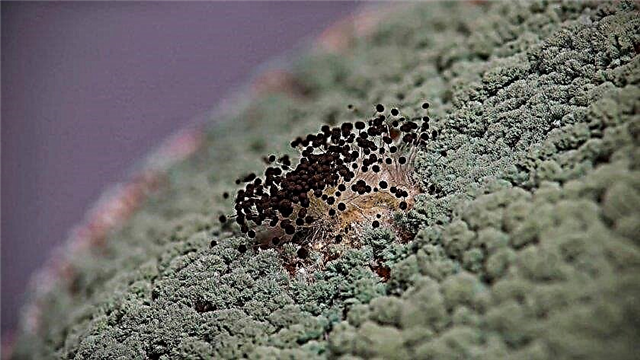
- Symptoms: A dense pure white mycelium appears on the surface. Later it acquires a green tint. Some types of green mold can affect the cap of the mushroom, showing green spots on it.
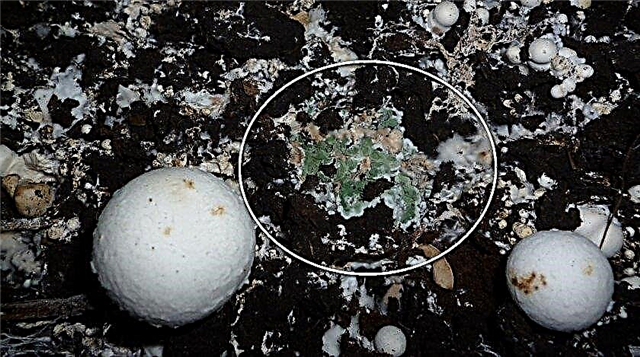
- Control measures: infection can be prevented by good room hygiene, proper preparation and conditioning of compost, sterilization of the additives used and the use of 2% formalin for surface treatment.
Also, the cause of fluff on the ground is false truffle is not a form of mold, but a separate pathogenic mushroom, which is a competitor of champignon in the struggle for nutrients. It is carried along with compost and, therefore, is a disease. It is activated in February or early March.
- Symptoms: the color of the mycelium will be white at first, and it will be fluffy, then it will acquire a creamy yellow hue and begin to thicken. It is clearly visible on the ground. The mycelium forms a dense winding pillow, within which spores develop. After 3 weeks, they are able to infect new areas.
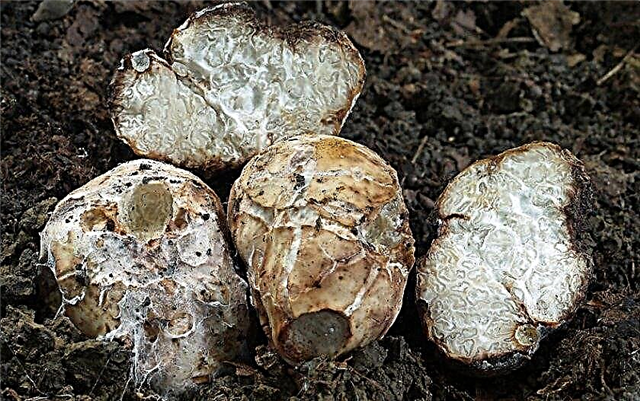
- Stage of infection and temperature are important factors in determining the severity of a disease. The optimal growth of the fungus was recorded at +26 ... + 28 ° С. But for germination it is enough that the air temperature is about + 16 ° C. False truffle depletes the main mycelium.
- Preventive measures: the pathogen can be destroyed by treatment with high temperature (60 ° C) for 2 hours. It is also advisable not to increase the temperature of the compost above + 20 ° C during the development of champignon mushrooms.
Important! Although heat kills fungi and bacteria, it does not destroy the toxins they create.
Fresh champignons
For the appearance of mold on champignons, you need:
- water;
- food;
- wet air;
- suitable temperature.
Mushrooms include water. During storage, it evaporates, but if the mushrooms are wrapped in polyethylene, then it has nowhere to evaporate. Also, the air temperature under the film will be higher than in the refrigerator as a whole. Developing, the fungus destroys (decomposes) the structure of the champignon, penetrating deep inside. For this reason just wash it off the surface and eat mushrooms after heat treatment is impossible.

In addition, the mold is resistant to high temperatures. This means that after boiling its spores still remain in the mushrooms. Therefore, throwing away a spoiled product will be much easier than treating poisoning. If you observe stains on products or see plaque, then they must be thrown away. If they are stored in the refrigerator for more than 2 weeks, then this is also an occasion to throw them out.
- Other signs of spoiled champignons:
- unpleasant odor;
- drying out;
- dark spots;
- slime;
- darkening of the surface as a whole.
Did you know? In nature, there are more than 10 thousand types of mold.
How to store mushrooms to protect from spoilage
Not everyone knows how to properly store mushrooms.
- Take note of a few basic tips to help extend their shelf life:
- Store mushrooms so that air circulates around them, and they do not dry out, but also do not get wet. A paper bag is the perfect packaging for this.
- If you wrap champignons in paper towels and then put them in polyethylene, the paper will absorb moisture, but it needs to be changed daily.
- Store them in sealed containers until used.
- You can freeze mushrooms for future use. First they need to be laid out on parchment in one layer. When the champignons are sufficiently frozen, they should be transferred to a sealed container.
- Another storage method is to cook the mushrooms first (for example, blanch or steam), and then pack them in an airtight container.
Proper storage of food prevents mold. But you can also simply revise your purchase standards in order to manage to use mushrooms before they spoil.




 At the beginning of development, it is creamy white, then gradually darkens and turns into a slimy shapeless black mass. The mushroom is a sign of the high nitrogen content in the compost heap and an indication that the compost was old.
At the beginning of development, it is creamy white, then gradually darkens and turns into a slimy shapeless black mass. The mushroom is a sign of the high nitrogen content in the compost heap and an indication that the compost was old.






